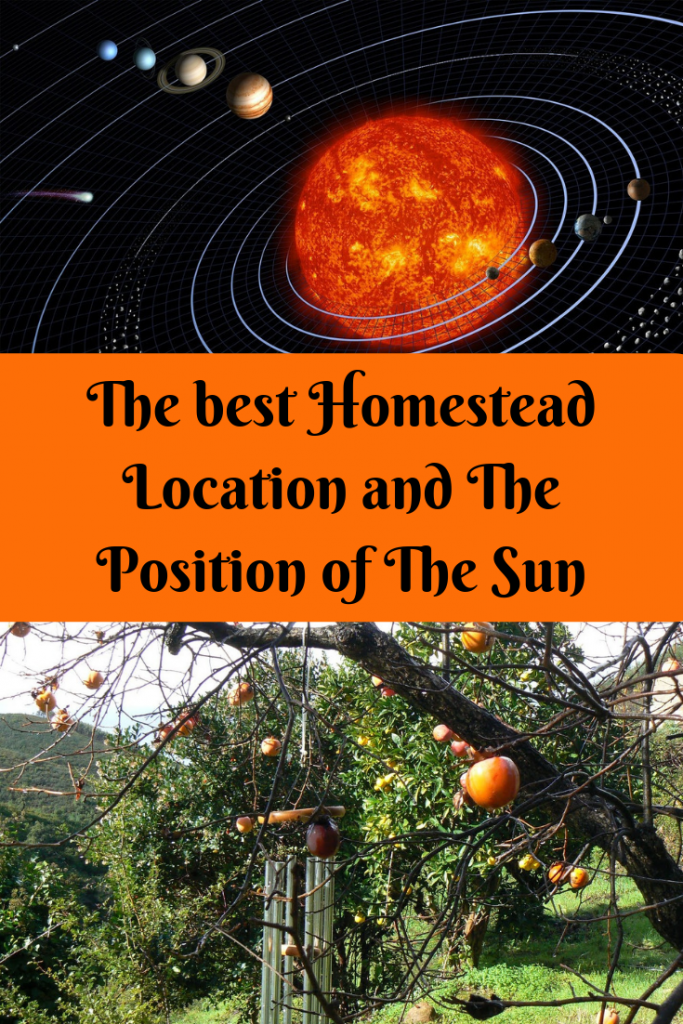
The sun is important for a lot of things. Your vegetable garden will not thrive without enough direct sunlight. The use of solar panels is only worth the effort when you have enough direct sunlight at the right angle. Light in your house during the day is desirable.
Knowing the position of the sun on your location is key to whether you will have enough sunlight on your Homestead.
At the other hand shade can also be important in places where it gets very hot in summer. Having to much hot burning sunshine in your vegetable garden will not be good for your lettuce and radishes. These crops, that need a lot of moisture will not grow in the burning hot sun.
Your house might heat up to much, instead you would want some coolness in the house in hot summers.
What is in this blog?
Why is it important to consider the latitude where you are? Apart from that the latitude partly defines the climate zone you are in, it also defines the height of the sun and the number of sun hours per day.
The higher the latitude the lower the maximum height of the sun. At a higher altitude the days will be longer in summer and shorter in winter.
The lower the altitude the less this difference in length of day and night get. In the tropics the days and nights are always almost equally long.
How to use this knowledge when you are looking for your ideal Homestead location?
There are two ways to use this knowledge for finding your Homestead location.
You can either look it up on a map and figure out what the position of the sun is on a location. You will have to look up the position of the sun in different seasons to get a complete picture. This way of figuring out the positions sun on a location might be useful in the first coarse surges for a location. Like when you are still working out a location behind your desktop. You will find out more about this at the end of the blog.
Once you have fount an area and you are going to investigate pieces of land the other way of inquiring the suns position comes in.
While you are standing at the location you want to check out, imagine that you are the center of the universe and picture the following things:
Once you know the sun´s arch in summer and winter, you can go a step further. The next thing will be: what time does the sun appear and disappear in midsummer and midwinter at the location? It seems to be something you can look up in a calendar.
Yes, you can. And it will work on flat terrain, but it will be different when you are looking somewhere in the mountains for a location. Mountains will be blocking the sun and will make a big difference in the amount of sun hours that you will get on a specific location.
Apart from mountains you could be checking out a location for other obstacles that can block the sun, like buildings or large trees. Where do these objects shade the location in summer and winter.
The location that you are checking out might be a larger area. Walk around on the location and see what differences there are on the location at any specific point.
This video made by the University of Nottingham gives a deeper inside about the position of the sun in different times of the year and in different altitudes.
For those who want to dive in even deeper this a tool that shows the exact position of the sun on any place on earth. It does not take the obstacles into account though. Based on the graphs you can picture it in real time. Although there is a tool that calculates the length of a shadow.
Click on the link below for the tool that shows the exact position of the sun:
| SunEarthTools.com |
I hope that this blog will help you to find the right location for your Homestead. Finding out the position of the sun can be of great help. Both methods of finding out about the amount of sunshine on your location, behind your desktop or on site will be useful in combination.
The video and site that I found will help you a little further when you are interested in making a technical effort on the subject.
If there is anything you would like to know more about the topic of the blog, do not hesitate to leave a question or comment below in the comment area.
Check this blogpost by clicking on the links:
5 Phases in Building a Homestead
5 Reasons Why We Started Our Homestead
Finding A Homestead Location With Good And Sufficient Fresh Water
Starting A Homestead In A Remote Area
